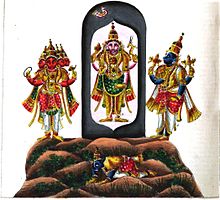三 相 神
创造、 | |
| त्रिमूर्ति | |
| trimūrti | |
| Om Tridevaya Namah | |
暗 质(暗 性 )表示 無知 、懶惰 及靈性 的 黑 暗 ,和 毀滅之 神 濕 婆 有 關 。為 黑色 ,對應 地球 上 的 火 。激 質 (忧性)表示 活動 、熱情 及新的 開始 ,和 梵天 有 關 。為 紅色 ,對應 地球 上 的 土 。純 質 (善 性 )表示 純 淨 、友 善 及和諧,和 毗濕奴 有 關 。為 白色 ,對應 地球 上 的 水 。[5]


發展
[编辑]

它的
最 值得关注的 表 现可以在三相神的宗教概念中发现,比 如至高 神 的 表 现形式 有 三 种形式 :梵天 、毗濕奴 、湿 婆 ……但 是 这种尝试可能 并不成功 ,因 为梵天 从没有 得 到 超 出 湿 婆 或 毗濕奴 的 统治地位 ,不同 的 教派 常常 认为三相神是自己教派的主神的三种表现形式,认为本 教派 的 主神 是 梵或 绝对真理 。[9]
莫里斯·
历史
早期 学 习印度 教 的 西方 学生 对与基督教 类似的 印度 教 的 三位一体 印象 深刻 。事 实上这种类似并不够紧密 。不 像 基督教 的 三位一体 ,印度 教 的 三位一体从没有真正“流行 起 来 (caught on)”。所有 的 印度 教 三位一体派都倾向于偏爱这三神中的某个神;因 此,从这个背景 来 看 ,很明显迦梨陀娑的 献 给三相神的赞美诗实际上是献给被认为是至高神的梵天的。三相神实际上是人为的拔高,并没有 太 多 的 真正 影 响。[12]
印度 教 中 的 观点
[编辑]绍拉派
[编辑]绍拉
毗濕奴 派
[编辑]
毗湿
湿 婆 派
[编辑]

传统派
[编辑]传统
参考 文献
[编辑]引用
[编辑]- ^ For quotation defining the trimurti see Matchett, Freda. "The Purāṇas", in: Flood (2003), p. 139.
- ^ For the Trimurti system having Brahma as the creator, Vishnu as the maintainer or preserver, and Shiva as the transformer or destroyer. see Zimmer (1972) p. 124.
- ^ For definition of trimurti as "the unified form" of Brahmā, Viṣṇu and Śiva and use of the phrase "the Hindu triad" see: Apte, p. 485.
- ^ For the term "Great Trinity" in relation to the Trimurti see: Jansen, p. 83.
- ^ Wolfgang Bauer, Irmtraud Dümotz, Sergius Golowin: Lexikon der Symbole. Heyne 2001
- ^ For dating of Puranic period as c. CE 300-1200 and quotation, see: Majumdar, R. C. "Evolution of Religio-Philosophic Culture in India", in: Radhakrishnan(CHI, 1956), volume 4, p. 47.
- ^ For characterization as non-homogeneous and including multiple traditions, see: Majumdar, R. C. "Evolution of Religio-Philosophic Culture in India", in: Radhakrishnan(CHI, 1956), volume 4, p. 49.
- ^ For harmony between orthodox and sectarian groups, see: Majumdar, R. C. "Evolution of Religio-Philosophic Culture in India", in: Radhakrishnan(CHI, 1956), volume 4, p. 49.
- ^ For quotation see: see: Majumdar, R. C. "Evolution of Religio-Philosophic Culture in India", in: Radhakrishnan(CHI, 1956), volume 4, p. 49.
- ^ Winternitz, volume 1, p. 452, note 1.
- ^ For references to Kūrma Purana see: Winternitz, volume 1, p. 573, note 2.
- ^ Basham, pp. 310-311.
- ^ Matchett, Freda. "The Purāṇas", in Flood (2003), p. 139.
- ^ "Brahma, Rudra and Vishnu are called the supreme forms of him. His portion of darkness is Rudra. His portion of passion is Brahma. His portion of purity is Visnu" Maitri Upanisad [5.2]
- ^ Sharma, B. N. Krishnamurti. A history of the Dvaita school of Vedānta and its literature: from the earliest beginnings to our own times. Motilal Banarsidass Publishers. 2000 [2010-01-15]. ISBN 81-208-1575-0. (
原始 内容 存 档于2012-11-05). - ^ How can the god of destruction be the Supreme ?. [2013-07-22]. (
原始 内容 存 档于2006-09-26). - ^ Flood (1996), p. 17.
- ^ Dating for the pañcāyatana pūjā and its connection with Smārta Brahmins is from Courtright, p. 163.
- ^ For worship of the five forms as central to Smarta practice see: Flood (1996), p. 113.
- ^ Grimes, John A. Ganapati: Song of the Self. SUNY Series in Religious Studies. Albany: State University of New York Press. 1995: p.162. ISBN 0-7914-2440-5.
来 源
[编辑]- 书籍
- Apte, Vaman Shivram. The Practical Sanskrit Dictionary Fourth revised and enlarged. Delhi: Motilal Banarsidass Publishers. 1965. ISBN 81-208-0567-4.
- Basham, A. L. The Wonder That Was India: A Survey of the Culture of the Indian Sub-Continent Before The Coming of the Muslims. New York: Grove Press, Inc.,. 1954.
- Flood, Gavin (Editor). The Blackwell Companion to Hinduism. Malden, MA: Blackwell Publishing Ltd. 2003. ISBN 1-4051-3251-5.
- Jansen, Eva Rudy. The Book of Hindu Imagery. Havelte, Holland: Binkey Kok Publications BV. 2003. ISBN 90-74597-07-6. Eighth printing; First published 1993.
- Radhakrishnan, Sarvepalli (Editorial Chairman). The Cultural Heritage of India. Calcutta: The Ramakrishna Mission Institute of Culture. 1956. Second edition, four volumes, revised and enlarged, 1956 (volume IV).
- Winternitz, Maurice. History of Indian Literature. New Delhi: Oriental Books Reprint Corporation. 1972. Second revised reprint edition. Two volumes. First published 1927 by the University of Calcutta.
- Zimmer, Heinrich. Myths and Symbols in Indian Art and Civilization. Princeton, New Jersey: Princeton University Press. 1972. ISBN 0-691-01778-6.

